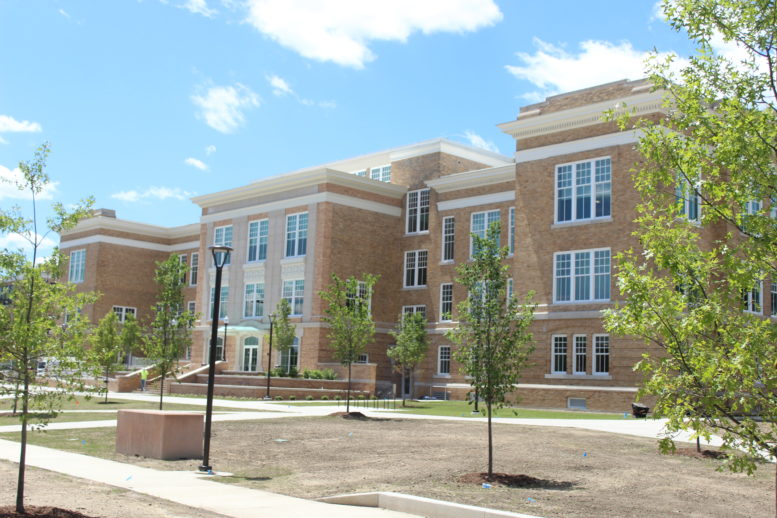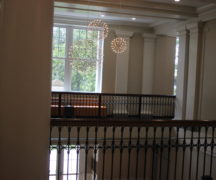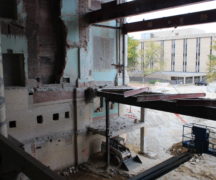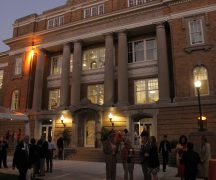By DAVID DUPONT
BG Independent News
Prospective students will be offered a grand entrance into Bowling Green State University when they visit the new admission offices in University Hall.
University Hall, one of the two oldest buildings on campus – Williams Hall just to the west was completed earlier in 1915 – is opening after a complete two-year makeover.
And like Moseley Hall, another of the original campus buildings, University Hall offers all the cutting-edge amenities of the early 21st century without losing its sense of a 100-year-old heritage.
Th projected final costs for the building renovations is $21 million for Moseley and $25 million for University Hall, according to the Office of Marketing and Communications.
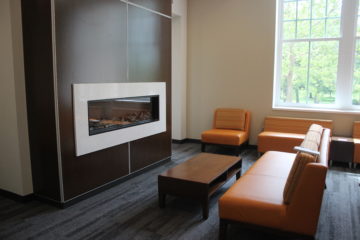
Decorative fireplace on second floor of University Hall.
The west entrance of University Hall has retained the marble staircase that sweeps upward to the second floor, the new home for the office of admissions.
“Of all the spaces in the building this is the one I’m most proud of,” said Brian Swope, the university’s assistant director of the office of design and construction, during a recent tour.
In renovating the stairway “we kept as many of the original pieces as we possibly could,” he said. Where the original fixtures had to be replaced, replicas were purchased.
That was true throughout the building.
Crews stripped away the work of earlier renovations, opening up space, and exposing original walls. Drywall was removed at the top of the stairwell. The marble stairs will be treated give them a better grip, Swope said.
Where a fireplace once graced the president’s office when the building first opened, a decorative fireplace has been installed in a lounge area on the second floor. A large window gives a view to the west.
“The biggest difference is all the natural light,” Kristi Peiffer, a project manager for the university office of design and construction, said. In many instances, the top half of the floor-to-ceiling windows had been covered up to save on energy. Now using high efficiency glass, those windows can be unblocked letting light in and offering views of the surrounding campus.
Swope said the buildings remain “true to form on the outside,” but inside they reflect the newest concepts.
Classrooms offer more flexibility. “The days of teaching stuck to the lectern in front of the classroom are gone,” Peiffer said.
University hall has a half-dozen classrooms, including one on the third floor that has flexible seating for 90 and a panoramic view with Jerome Library rising in the east.
That classroom is in what remains of what became the theater wing housing the original Eva Marie Saint and Joe E. Brown theaters. The wing with an auditorium and a gymnasium above had been added onto the building right after the building was originally constructed.
Most of the wing was removed, and a new east entrance constructed. Tim Burns, a senior project manager, said the architects BHDP modeled the work on the west entrance. The new east entrance opens out into a plaza.
Once neighboring Hanna Hall to the south is renovated and expanded as the new home of the College of Business, the parking lot will be removed to form a south-north avenue into the heart of campus.
In addition to admissions and classrooms, University Hall houses “high impact” programs.
Undergraduate advising and academic services is on the first floor right off the west entrance.
Though the office had just recently moved into the renovated building, Deb Cunningham, administrative assistant for the office, said she already felt at home.
The office had been in University Hall before being displaced for the renovation. “It feels nice to be in our building,” she said.
Cunningham was pleased with the new open feel of the space, and pleased that “they’ve kept so many things that really define the building.”
Also on the first floor is the Center for Civic and Community Engagement and the Learning Communities office.
The third floor includes International Programs and Partnerships, the Innovative STEM Education project office, and the Center for Undergraduate Research and Scholarship.
That means that the building will serve every BGSU student in some way.
Burns said that working on these historic structures was rewarding. Still, “they’re old buildings so they’ll throw some curveballs at you,” he said. “We’ve been able to hit all the curveballs.”
In Moseley, for example, “we presumed all the footings extended down to bedrock, a few did not had to excavate down to get those footings to bedrock.”
The addition to University Hall, Burns said, was not flush with the original structure. That was a challenge to resolve.
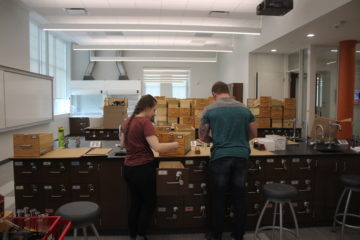
Bethany Abbott, a graduate student in forensic science, and Landon Rohrerm an undergraduate chemistry major, unpack kit boxes moved from Overman Hall into new cabinets in Moseley Hall.
Moseley opened in 1916 as the home of the agricultural science program. Now it will hold laboratories for chemistry, biology, geology, and medical lab science. “It’s returning to its roots,” Burns said.
Except “we will not be bringing the cows back,” Swope said.
Originally there was an area to bring in cattle on the building’s first floor, Burns said.
The courses taught in Moseley will be for first- and second-year students. That means a significant number of BGSU students, whether or not they are science majors, will end up taking a course in Moseley.
In addition to labs, the building also has a variety of informal collaboration spaces. These encourage informal meetings among students and faculty. Some have room for several people, some are designed for one-to-one meetings.
All this built with the needs of those who will teach there in mind. “That’s the key,” Burns said, “making sure the faculty is involved with the design.”
The public will have a chance to tour the buildings on Thursday Aug. 10 and Saturday, Aug. 12. For details click here.

